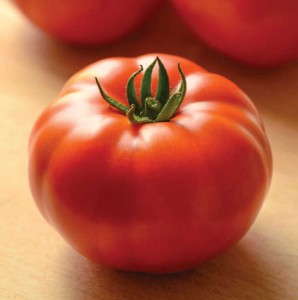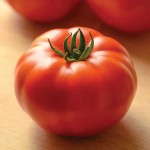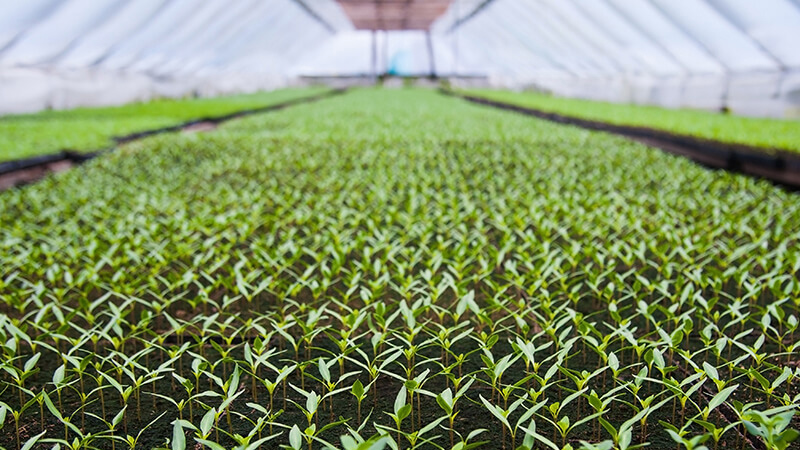Fresh Vegetables Create Fresh Markets

‘Genuwine’ tomato is part of the Heirloom Marriage collection from PanAmerican Seed. ‘Genuwine’ is a cross between ‘Costoluto Genovese’ and ‘Brandywine.’
There’s nowhere for the vegetable trend to go but up, say experts from top breeding companies who have their eyes closely on the market. The demand for unique, flavorful, locally grown vegetables and fruit is growing, and new farmers’ markets and roadside stands are continuing to open and flourish.
While patio vegetables are still quite popular, breeders are also noticing that home gardeners with even a small plot of land are jumping on the bandwagon, as well. Breeders are looking for varieties that will suit those gardeners and the fresh market farm sector.
Eat Local Movement Creates New Markets
“We are not breeding tomatoes that are suitable for transportation 3,000 miles away,” says Josh Kirschenbaum, new crops manager for PanAmerican Seed. “Flavor is our primary emphasis, as well as exceptional fruit quality and earlier and longer harvest. That’s really important if you are a fresh market farmer or a home gardener. We are also figuring out how our products can be used to extend the season, such as in high tunnels and greenhouses.”
Kirschenbaum says he is well aware of the trend of flower growers beginning to grow vegetables during the gaps in
their seasons.
“We’ve started working with growers to see their operations, and are looking at ways we can fit our existing varieties into those systems, as well as think about some of the new varieties we are working on for the future,” he says. “A lot of growers have been doing this for just a year — it’s a perfect tie-in for us to start investigating, because we are learning together. We also have a group of customers we have worked with for many years, and we can get products into their hands right away for them to trial. We want to get their feedback.”
Jeannine Bogard, business product manager for Syngenta Flowers, says vegetables are not a one-size-fits-all solution for everyone, and it is important for the industry to look into the demographic makeup of the gardener.
“The way to position vegetables with each [demographic] group is going to be different depending on where they are in life,” she says. “You’ve got to look at the footprint of where they live. If there are small footprints, you want to offer a container program. But if they are participating in a community garden, then the plants can go in the ground.”
Bogard says she sees more young people wanting to grow their own food.
“There are so many things driving their interest in growing their own right now,” she says. “The food safety issues, the eat local movement and the trend toward more gourmet cooking are big factors.”
New Genetics Raise Productivity
With new genetics, or enhanced versions of old ones, it’s not necessary to have the large, half-acre garden of your grandparents to grow a useful amount of produce. Bogard says she is “bringing the farmers’ market to the front porch.”
“All the benefits the local farmer enjoys — disease resistance, high-yield — makes an easy-to-grow experience for the home gardener,” Bogard says.
At PanAmerican, Kirschenbaum is also working on increased productivity. One example he cites is the new heirloom tomato series, Heirloom Marriage. While many heirlooms are bred with modern varieties to increase productivity and disease resistance, the Heirloom Marriage varieties have two heirloom parents.
“Heirlooms are very popular right now,” Kirschenbaum says. “We looked at hundreds of varieties and chose the ones we liked for color, shape and especially flavor, and started crossing them. The Heirloom Marriage varieties have much higher yields, fewer fruit blemishes and are much earlier to mature.”
Kirschenbaum says this series is a good example of how new breeding can tap into the farmers’ market sector.
“Heirlooms aren’t very productive, but people still want them, so farmers are still growing them,” he says. “But they are not having a lot of success or productivity with them. Neither are home gardeners, for that matter. So this series will give some nice added value to those folks.”
Being Different Makes All The Difference
While many flower growers like to stick with tried-and-true varieties, Bogard says they should try a different approach with vegetables.
“Vegetable people will make room for one more thing,” she says. “There’s a group of gardeners out there who are trolling for that new plant. And they are having a hard time finding it. That’s why the mail-order companies are doing so well — some have 200 to 300 varieties of tomatoes. Veggies are trending. I think the only thing that will hold the trend back is that we aren’t feeding that urge to have something different. Growers say, ‘I won’t grow it unless they ask for it.’ I say, they are asking for it, but we aren’t listening.”
The internet can play a role, as well.
“I was asked by a commercial customer about a tomato called ‘Carmello,’” Bogard says. “It has been on the market for awhile. I looked into it and found out ‘Carmello’ has a huge following online. It’s a French hybrid with a thinner skin, 5- to 7-ounce red fruit, great productivity and full flavor. It’s a home garden variety, and now we are offering it.”
Kirschenbaum also sees the desire for flavor and uniqueness as paramount, saying cooking shows, blogs and websites that focus on cooking are creating that interest.
“There is a trickle-down effect,” he says. “If a farmers’ market has something different available, people will buy it and like it and may want to grow it. If a chef mentions something on TV, everyone wants it.”
Selling The Story
With vegetables, it’s not really as much about how the plant looks in the garden as it is with flowers. It’s about the back-end performance — the harvest. It’s important to tell that story to customers so they understand the real value of what the plant will provide.
PanAmerican is grouping many of its vegetable offerings as the HandPicked Collection. Most have been on the market for several years, and are suitable for home gardeners and the fresh market garden.
“This is something important to us that we intend to grow into the future,” Kirschenbaum says. “We have a nice cohesive collection now and are ready to introduce it to the world.”
Marketing materials have been developed to tell the story of the varieties in the collection, including bin cards growers can download and print.
Bogard says vegetables are about eating and sharing, and growers need to adapt their mindset accordingly.
“When I talked about how to grill vegetables and what to do with them at one of our trials, growers were suddenly interested,” she says. “When I shared what they were going to experience later in the summer, not what they were going to deal with in the greenhouse, they got all excited.”
The Future Is Bright
Kirschenbaum says the demand for locally grown vegetables will continue to grow.
“It’s something that makes sense to people, whether it is about the cost of transporting a head of lettuce from California to Ohio or about the nutritional value of locally grown food,” he says. “Whether local in your backyard or local at a farmers’ market, is not just a fad because it really makes sense.”










